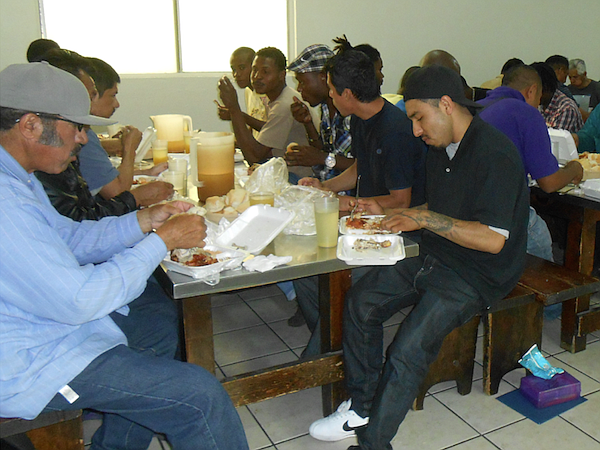 Facebook
Facebook
 X
X
 Instagram
Instagram
 TikTok
TikTok
 Youtube
Youtube

On May 26 at high noon, Casa del Migrante in Tijuana received a phone call from the regional delegate of Mexican immigration for a 2:00 p.m. emergency meeting.
Casa del Migrante representatives learned that refugees from all over the world had started to arrive at the Tijuana border crossing looking for political asylum in America. U.S. authorities were ill-prepared and could not process the number of people arriving at the border.
By the time the refugee center learned of the crisis, there were already 400 people seeking refuge, and U.S. authorities were not letting anyone else into the documentation checkpoint building in San Ysidro. A line of 100 men, women, and children had formed along the border crossing. Casa del Migrante was asked to give care to those waiting.
The following day, Casa del Migrante began serving, alongside immigrants and deportees, refugees from the world over. It was not easy to convince the people to come to their center. After three hours of negotiations, most agreed to follow the volunteers, though they remained skeptical.

“The big crisis is that the U.S. cannot process folks fast enough, and so they have to wait on the street,” says Casa del Migrante director Fr. Pat Murphy.
Mexican immigration authorities asked for the Casa’s help on May 25th and since then four other shelters have opened their doors.
“The people who come to the shelter are put on a waiting list and when their number comes up, Mexican authorities pick them up and bring them to the front of the lines,” Murphy explains.
"I'm surprised by the number of foreigners,” U.S. consul general William Ostick told Agence France‑Presse. “They don't usually arrive in such large numbers, and they usually come to other border crossings like Laredo [Texas].”
There is a Casa del Migrante in Nuevo Laredo, but that house has yet to receive anyone looking for asylum.
“[This has taken] us all by surprise,” Murphy says. “Those arriving now are coming by word-of-mouth. ‘Why Tijuana?’ is the million-dollar question and I just do not know. Haitians are the biggest group we have had in the Casa — nearly 60 in 11 days and all are coming from Brazil.”
Brazil is reportedly suffering its worst recession since the 1930s. Last month, the Brazilian senate voted to impeach president Dilma Rousseff.
“So, the push to the U.S.A. is understandable,” says Murphy. “The authorities moved the people off the line for a few days to a local park, I think to get them out of sight. Yesterday [June 8, refugees] were in the park and also lining up and someone counted a total of 300 men, women, and children from a variety of countries.”
On the night of June 7, authorities moved the refugees out of the park to a gym-like building. Volunteers agreed that the gym was not suitable; one day after removing them, the refugees were brought back. The Mexican government maintains there is no emergency and that the situation is under control.
“They are trying to treat people as humanely as possible,” says Murphy, “but we still lack an organized response from all facets of the government.”
Since the Tijuana mayoral election took place on May 29, Murphy hopes that the situation can be resolved. Yet, he says there are still approximately 100 people per day lining up. Casa has so far received 150 people from 11 countries.
“I expect this to get worse,” says Murphy. “Because people keep coming and word-of-mouth will travel fast. The people we are seeing are desperate and those coming from places like [the Mexican state of] Guerrero are literally running for their life to escape the violence.”
Although it’s improving, U.S. authorities remain slow at processing people. They have promised 24-hour turnarounds, which they’ve yet to accomplish.
“There is just no good reason to have women and children sleeping on the street for four to five days without getting an answer,” Murphy said. “They can and must do much better. This story needs to be told in the U.S.A. so the authorities can be shamed into doing a better job.”
Casa del Migrante volunteers have heard stories about people allowed into the U.S. who are now with their families. Some Haitians have gone to places such as Miami, Atlanta, and New Jersey; some wish to go to Los Angeles. Murphy says most people are not headed to San Diego and that most people seem to have family somewhere in the U.S.
According to Murphy, 42 Mexicans from Guerrero and Michoacán — mostly women and children — were scheduled for asylum appointments with U.S. authorities on June 8; so, too, were 14 Haitians and 1 Armenian.
Numerous refugees have told Casa del Migrante volunteers that “thousands” more are coming.
“I am not sure yet,” Murphy theorizes, “but I think somehow there are some highly organized smugglers who came up with a new way to make money on the backs of poor migrants, who pay large sums of money to cross through the borders of several countries.”


On May 26 at high noon, Casa del Migrante in Tijuana received a phone call from the regional delegate of Mexican immigration for a 2:00 p.m. emergency meeting.
Casa del Migrante representatives learned that refugees from all over the world had started to arrive at the Tijuana border crossing looking for political asylum in America. U.S. authorities were ill-prepared and could not process the number of people arriving at the border.
By the time the refugee center learned of the crisis, there were already 400 people seeking refuge, and U.S. authorities were not letting anyone else into the documentation checkpoint building in San Ysidro. A line of 100 men, women, and children had formed along the border crossing. Casa del Migrante was asked to give care to those waiting.
The following day, Casa del Migrante began serving, alongside immigrants and deportees, refugees from the world over. It was not easy to convince the people to come to their center. After three hours of negotiations, most agreed to follow the volunteers, though they remained skeptical.

“The big crisis is that the U.S. cannot process folks fast enough, and so they have to wait on the street,” says Casa del Migrante director Fr. Pat Murphy.
Mexican immigration authorities asked for the Casa’s help on May 25th and since then four other shelters have opened their doors.
“The people who come to the shelter are put on a waiting list and when their number comes up, Mexican authorities pick them up and bring them to the front of the lines,” Murphy explains.
"I'm surprised by the number of foreigners,” U.S. consul general William Ostick told Agence France‑Presse. “They don't usually arrive in such large numbers, and they usually come to other border crossings like Laredo [Texas].”
There is a Casa del Migrante in Nuevo Laredo, but that house has yet to receive anyone looking for asylum.
“[This has taken] us all by surprise,” Murphy says. “Those arriving now are coming by word-of-mouth. ‘Why Tijuana?’ is the million-dollar question and I just do not know. Haitians are the biggest group we have had in the Casa — nearly 60 in 11 days and all are coming from Brazil.”
Brazil is reportedly suffering its worst recession since the 1930s. Last month, the Brazilian senate voted to impeach president Dilma Rousseff.
“So, the push to the U.S.A. is understandable,” says Murphy. “The authorities moved the people off the line for a few days to a local park, I think to get them out of sight. Yesterday [June 8, refugees] were in the park and also lining up and someone counted a total of 300 men, women, and children from a variety of countries.”
On the night of June 7, authorities moved the refugees out of the park to a gym-like building. Volunteers agreed that the gym was not suitable; one day after removing them, the refugees were brought back. The Mexican government maintains there is no emergency and that the situation is under control.
“They are trying to treat people as humanely as possible,” says Murphy, “but we still lack an organized response from all facets of the government.”
Since the Tijuana mayoral election took place on May 29, Murphy hopes that the situation can be resolved. Yet, he says there are still approximately 100 people per day lining up. Casa has so far received 150 people from 11 countries.
“I expect this to get worse,” says Murphy. “Because people keep coming and word-of-mouth will travel fast. The people we are seeing are desperate and those coming from places like [the Mexican state of] Guerrero are literally running for their life to escape the violence.”
Although it’s improving, U.S. authorities remain slow at processing people. They have promised 24-hour turnarounds, which they’ve yet to accomplish.
“There is just no good reason to have women and children sleeping on the street for four to five days without getting an answer,” Murphy said. “They can and must do much better. This story needs to be told in the U.S.A. so the authorities can be shamed into doing a better job.”
Casa del Migrante volunteers have heard stories about people allowed into the U.S. who are now with their families. Some Haitians have gone to places such as Miami, Atlanta, and New Jersey; some wish to go to Los Angeles. Murphy says most people are not headed to San Diego and that most people seem to have family somewhere in the U.S.
According to Murphy, 42 Mexicans from Guerrero and Michoacán — mostly women and children — were scheduled for asylum appointments with U.S. authorities on June 8; so, too, were 14 Haitians and 1 Armenian.
Numerous refugees have told Casa del Migrante volunteers that “thousands” more are coming.
“I am not sure yet,” Murphy theorizes, “but I think somehow there are some highly organized smugglers who came up with a new way to make money on the backs of poor migrants, who pay large sums of money to cross through the borders of several countries.”
Comments